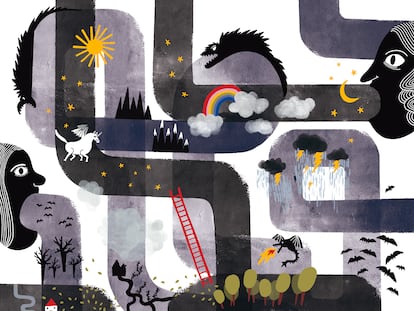The fascinating ritual of reading bedtime stories and what it reveals about humans
Our ancestors told stories to ward off fear. The routine has shaped us as a species

The day comes to an end. Neither you nor your children have anything left to give, but you cannot skip the ritual of reading them a story. And you still enjoy it, although something warns you that the expiration date is coming soon. They will soon reject story time all together, dismissing it as babyish as they aspire to be treated like adults. But it hasn’t happened yet, and in the meantime, you continue enjoying the nightly routine.
We are all made of stories. I write that sentence knowing that it is far from original. When I Google it, I see that it is attributed to Eduardo Galeano. But I would argue that not even he was the first to think of it.
Our brains are terrified of chaos, of the lack of meaning, of things happening without a reason. Our neurons are constantly processing and analyzing the information they receive. The power of our mind creates patterns and stories, ordering pieces that, at first sight, are not related, and seeking meaning in everything.
In the external universe and in our interior worlds, every action has a reaction. But it would be a stretch to say that there exists a single story with a coherent narrative. That would enter into the realm of religions, which have their own heroes and villains. Religions tell stories that scare away the ghost of the unpredictable and meaninglessness of life.
We need stories, even those without happy endings, and we seek them out from childhood. Despite the proliferation of screens, the overstimulation of countless stories around us, there are still millions of children who fall asleep to an adult reading them a story every night. It may seem an anachronism, an artifact from another time, but technological changes have not done away with the time-honored ritual of a parent reading aloud a picture book.
We may think that the stories we tell have changed over the thousands of years of our species. The Homo sapiens that lived in a cave did not have the same adventures as those who navigate on the internet or go to work at an office. But there is something primitive in our stories that has remained unchanged. We still have the same brains as our ancestors, which continues interpreting reality just as they did and being stimulated by the same things. As José Enrique Campillo says, our brain was not created to conceive of the vastness of the universe nor the infinitesimal size of the quantic, realities that we now face with a neural tissue designed for more immediate challenges.
But to understand those concepts, we use the same methods as our ancestors. The stories that captivate us are the ones that manage to interrupt our internal monologues, which give much-needed meaning to whatever we come across. Our brain is in charge of giving coherence to chaotic events.
For a story to catch our attention, it must have a beginning that breaks with expectations. It may even contain some magic words that, in a certain way, act as a spell, a rite that indicates that we must abandon what we knew to enter a new world. In this sense, “Once upon a time” can be as effective as “Mother died today. Or maybe yesterday; I can’t be sure.” Different strategies, same result.
When we read a story for the first time, the combination of what we see and the action of our brain will decipher what the author previously encoded. Our minds, and by extension that of the children who listen to us, build reality at the same pace with which we scan each word, and even anticipate what comes next, in a dizzying succession of possibilities until there is only one option left.
Every night, with each reading, in a penumbra broken by a small lamp, one of the most fascinating processes of a day full of almost magical moments takes place. When we read what someone previously imagined, perhaps with the help of images created by an illustrator, we set in motion powerful mental processes, which surely go as unnoticed as those that allow us to decipher the time on the face of a clock. At the same time, by speaking the words out loud, we add layers upon layers of magic. If each reading is unique, if each reader reconstructs in their own way what the author previously imagined, the child does the same from what they hear.
From that combined effort of the author, the adult who reads and the child who listens emerges an enduring moment. Perhaps that is why telling a story to a child continues to be a ritual. Perhaps that is also why it has managed to keep up with the tsunami of new screens and platforms. And I hope it continues to do so.
Sign up for our weekly newsletter to get more English-language news coverage from EL PAÍS USA Edition
Tu suscripción se está usando en otro dispositivo
¿Quieres añadir otro usuario a tu suscripción?
Si continúas leyendo en este dispositivo, no se podrá leer en el otro.
FlechaTu suscripción se está usando en otro dispositivo y solo puedes acceder a EL PAÍS desde un dispositivo a la vez.
Si quieres compartir tu cuenta, cambia tu suscripción a la modalidad Premium, así podrás añadir otro usuario. Cada uno accederá con su propia cuenta de email, lo que os permitirá personalizar vuestra experiencia en EL PAÍS.
¿Tienes una suscripción de empresa? Accede aquí para contratar más cuentas.
En el caso de no saber quién está usando tu cuenta, te recomendamos cambiar tu contraseña aquí.
Si decides continuar compartiendo tu cuenta, este mensaje se mostrará en tu dispositivo y en el de la otra persona que está usando tu cuenta de forma indefinida, afectando a tu experiencia de lectura. Puedes consultar aquí los términos y condiciones de la suscripción digital.
More information
Últimas noticias
Most viewed
- Sinaloa Cartel war is taking its toll on Los Chapitos
- Oona Chaplin: ‘I told James Cameron that I was living in a treehouse and starting a permaculture project with a friend’
- Reinhard Genzel, Nobel laureate in physics: ‘One-minute videos will never give you the truth’
- Why the price of coffee has skyrocketed: from Brazilian plantations to specialty coffee houses
- Silver prices are going crazy: This is what’s fueling the rally










































